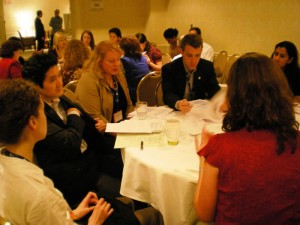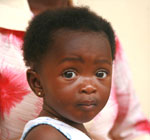The Infant & Young Child Nutrition (IYCN) Project team brought together nutrition, agriculture, and other global health colleagues for a lively session at the Global Health Council’s annual conference on June 14, 2010. Within the context of vastly increased public- and private-sector funding for agricultural development, participants discussed the intersection between agriculture and nutrition and explored a nutritional impact assessment tool to help program planners meet the vision of the many new initiatives addressing nutrition, global hunger, and food security.
Do good, but first do no harm
The IYCN Project’s technical director, Dr. Tom Schaetzel, discussed the need to build positive nutritional impact into agriculture and food security interventions. While food security is an important factor influencing nutrition, agriculture projects that focus exclusively on increased production and incomes may have little impact on food security and nutrition. In some cases, these projects can have a negative impact on the nutritional status of vulnerable groups.
Dr. Schaetzel presented a review of 35 years of agricultural projects to identify factors associated with improved food security and nutrition, and factors associated with reduced food security and worsened nutritional status. To maximize nutritional benefits and avoid a negative impact on nutrition, Dr. Schaetzel argued, the design of agricultural interventions should focus on activities that improve nutrition and food security for the most nutritionally vulnerable groups, particularly mothers, infants, and young children.
Secretary Clinton on a new approach to nutrition
“…we’re putting an end to the stove-piping that has long hindered our government’s nutrition efforts. For years, experts have been saying that [nutrition] is a problem that must be addressed through a comprehensive response that unites experts and programs from across different fields. But for too long, the agricultural experts didn’t talk to the neonatal experts who didn’t talk to the early childhood experts.”
Secretary of State Hillary Clinton, at CARE’s 2010 National Conference and Celebration, May 2010
A new tool to assess nutritional impact
Dr. Schaetzel proposed a nutritional impact assessment tool for inclusion in the design process for agriculture projects. Much as environmental and gender impact assessments are de rigueur in development planning, the nutritional impact assessment would prompt consideration of a project’s impacts on the nutritional situation of vulnerable groups.
 Participants tried out the tool during a small group exercise, assessing a hypothetical (but reality-based) agriculture project. Each group followed the tool’s simple steps to assess the intervention using nutrition data to estimate likely nutrition outcomes and comparing the intervention to potential alternative approaches. Following the exercise, participants gave feedback on using the tool and discussed challenges such as collecting data and building capacity to implement the tool.
Participants tried out the tool during a small group exercise, assessing a hypothetical (but reality-based) agriculture project. Each group followed the tool’s simple steps to assess the intervention using nutrition data to estimate likely nutrition outcomes and comparing the intervention to potential alternative approaches. Following the exercise, participants gave feedback on using the tool and discussed challenges such as collecting data and building capacity to implement the tool.
Many participants suggested that the tool provides an opportunity for nutrition and agriculture program planners to collaborate in the name of common interests. Participants agreed that it is important to address nutritional concerns when designing agriculture programs and the tool could provide a new way to consider the impact on nutrition for mothers and children. Several attendees voiced interest in testing and implementing the tool.
The IYCN Project plans to work together with agriculture and nutrition program planners to refine the tool for use in designing agriculture interventions.
We need your help to further develop and test the draft nutritional impact assessment tool. Please contact Tom Schaetzel at info@iycn.org if you would like to join us in developing and using the tool.
Seminar materials
Download the PowerPoint: Maximizing Nutritional Benefits from Agricultural Interventions.
Date: Jun 22, 2010 | Category: Events

